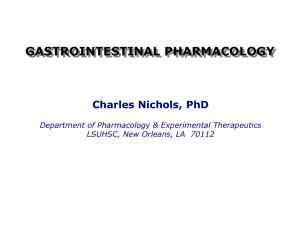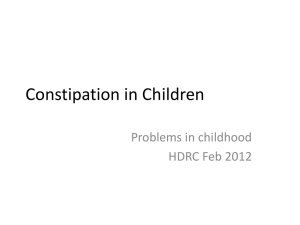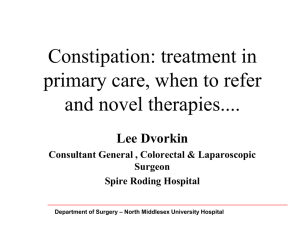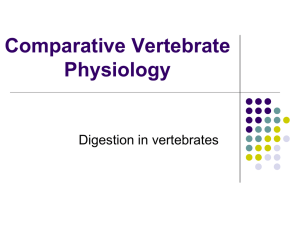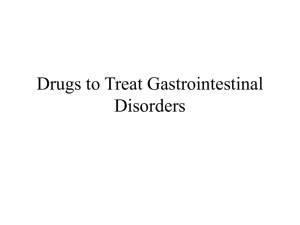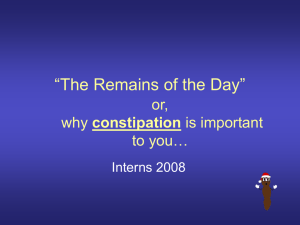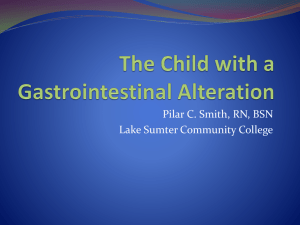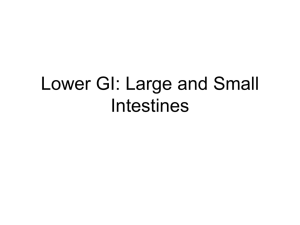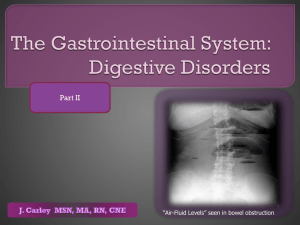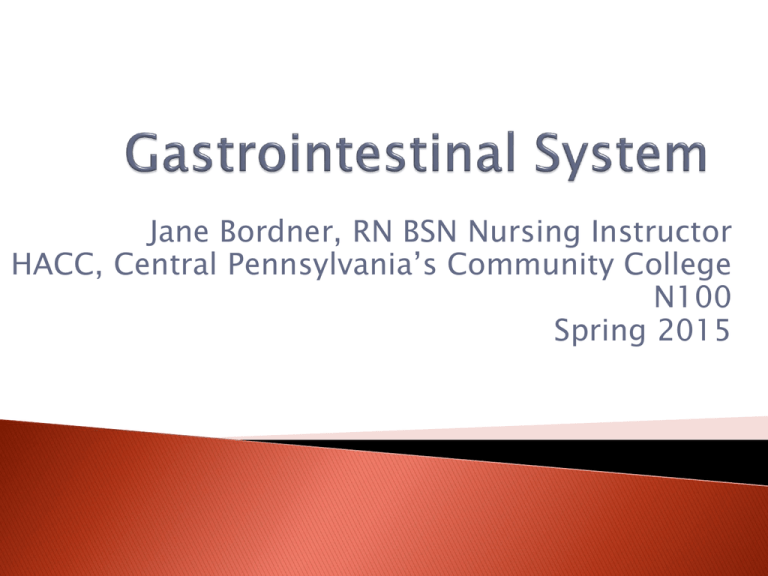
Jane Bordner, RN BSN Nursing Instructor
HACC, Central Pennsylvania’s Community College
N100
Spring 2015
Flexible, hollow, muscular tube
26 feet
Lined with mucous membrane
Principle responsibility of GI tract
Occurs in mouth, stomach, and small
intestines
Majority in small intestines
Teeth break food into smaller pieces
Saliva dilutes and softens bolus of food
Amylase begins chemical break down
Tongue:
◦
◦
◦
◦
Made of skeletal muscle
Contains taste buds
Keeps food between teeth
Elevates to move food back into pharynx
Passage of food from oral cavity to esophagus
Muscular tube
Constrictor muscles that contract as part of
swallowing
Carries food from
pharynx to stomach
No digestion
Food passes through
upper esophageal
sphincter
Peristalsis pushes
food through
cardiac sphincter
Tasks
Produces and secretes
◦ Storage
◦ Mixing
◦ Emptying
◦ Hydrochloric Acid (HCl)
◦ Pepsin
◦ Mucus
◦ Intrinsic factor
Segmentation
Peristalsis
7 to 10 L of liquid moves through in one day
Chyme is reduced to a volume of 600 to 800
ml that is paste-like consistency
3 Sections:
◦ Duodenum – 2 feet long
Continues to process chyme
◦ Jejunum – 5 feet long
Absorption of CHO and protein
◦ Ileum – 12 feet long
Absorption of H2O, fat, and bile salts
Most nutrients and electrolytes are absorbed
Impaired
function
Digestive process is altered
◦ Conditions such as
Inflammation
Ulceration
Surgical resection
Obstruction
Lower GI tract/Large Colon
Bowel elimination
Larger diameter
5 to 6 feet in length
3 sections
◦ Cecum
◦ Colon
◦ Rectum
Chyme enters through ileocecal valve
Cecum is 1st part
Colon sections
◦
◦
◦
◦
Ascending
Transverse
Descending
Sigmoid
Rectum and Anal Canal
4 Functions
◦ Absorption
H2O
Na & Cl
◦ Protection
bacteria
◦ Secretion
Bicarbonate and K
◦ Elimination
Bulk waste
Pancreas
Liver
Gall
bladder
Gland
Posterior to stomach
Exocrine = secretes
pancreatic juices
◦ Amylase = CHO
◦ Lipase = Fats
◦ Trypsin = Protein and
bicarbonate
Endocrine
Largest organ in body
Remarkable and complex
O2 rich blood received
through hepatic arteries
Nutrient rich blood received
through portal vein
2 lobes
Secretes
bile
Produces bilirubin
Removes nutrients from blood
Stores vitamins and iron
Converts glucose to glycogen
Stores glycogen
Converts
excess fatty acids and
urea
Helps metabolize proteins, fats,
and CHO
Detoxifies drugs and poisons
Phagocytizes bacteria and old
RBC’s
Stores
and concentrates bile
Hormone CCK (cholecystokinin)
◦ secreted by intestinal mucosa
◦ stimulates gall bladder to contract and
release bile
Disease process
Chemical/physical trauma
Social/economic factors
Stress/emotional factors
Congenital defects
Aging process
History (SUBJECTIVE AND OBJECTIVE)
Inspection (LOOK)
Auscultation (LISTEN)
Palpation (FEEL)
Percussion
W
H
A
T
S
U
P
-
Where is it?
How does it feel?
Aggravating and alleviating factors?
Timing?
Severity?
Useful other data?
Patient perception of problem?
Also include medications, nutritional assessment,
family history, cultural influences, height and
weight
RUQ
RLQ
LUQ
LLQ
Obstruction
Series
Upper GI/Barium Swallow
Lower GI/Barium Enema
◦
◦
◦
◦
◦
Light, low fat, low residue diet for 2 days
Clear liquid dinner evening before
NPO after midnight
Stimulant laxative night before
Enemas until clear or Colyte/Golytely prep
**Bowel must be clean of stool for
accurate results**
EGD
ERCP
Sigmoidoscopy/Colonoscopy
Eliminates need for exploratory surgery
Collection of biopsy material
Remove foreign objects
Preparation
Post-procedure
◦ NPO 6 to 12 hours before
◦ Use of local anesthetic to control gag reflex
◦ NPO until gag reflex returns
◦ Watch for signs of perforation and/or bleeding
post-op
Visualize colon and sigmoid area
Empty bowel prior to test
◦ Bowel Prep
2 day prep (outpatient)
Clear liquid diet for 1 - 2 days
Enema until clear or Go-lytley prep
◦ IV sedation may be used during procedure
◦ Patients find this test intrusive
More sensitive than x-ray
Non-invasive, no pain
May prep with contrast (clear)
Extremely sensitive
Visualizes changes in structure and tissue
Outlines
borders of structures
◦ liver, pancreas, gall bladder
Amylase and lipase blood levels
Liver enzymes (AST, ALT, LDH)
◦ Pancreatic function
◦ Liver function
Bilirubin
Ammonia
◦ Liver function
◦ Breakdown of RBC’s
◦ Liver function
Albumin
Prothrombin time
Gastric Analysis
Stool Exams
◦ Liver function
◦ Liver function
◦ pH
◦
◦
◦
◦
◦
Infection, parasites, organisms
Hemoccult (guaiac)
Consistency
Color
Odor
Anatomy and Physiology
Where is the cardiac sphincter located?
Where is the pyloric sphincter located?
Where is the ileocecal valve located?
List the 3 segments of the small intestine
◦ _____________________
◦ _____________________
◦ _____________________
Where does most absorption of nutrients
take place?
List 5 digestive juices and the organs that
secrete them
◦
◦
◦
◦
◦
_________________
_________________
_________________
_________________
_________________
___________________
___________________
___________________
___________________
___________________
Which nutrients enter the blood stream
directly?
Which nutrients enter the lymph system first?
Describe peristalsis
List exocrine function of pancreas
List function of gall bladder
List functions of liver
◦
◦
◦
◦
◦
◦
◦
◦
___________________________________________
___________________________________________
___________________________________________
___________________________________________
___________________________________________
___________________________________________
___________________________________________
___________________________________________
Remove gas and fluids from
stomach (decompression)
Obtain gastric secretions
for analysis
To relieve/reduce
obstructions or bleeding
Promote healing after
surgery – prevent strain on
sutures
Remove toxic substances
(lavage with poisonings)
Ask client to speak
Inspect pharynx
Instill 15 – 30 ml of
air while listening
over stomach
Aspirate gastric
contents
◦ Assess color
◦ Assess pH
Gastric secretions: < 4
Assessing Drainage
Irrigation
Intravenous
hyperalimentation
o Burns, trauma, malnutrition,
cancer
o
Constipation
Impaction
Diarrhea
Flatulence
Incontinence
Hemorrhoids
Gastritis
Gastric Ulcer Disease
GERD
Decreased BM
Hard, dry stool
Causes
Nursing
Interventions
Nursing Diagnosis
Goal
Interventions
Who is at risk???
Risk factors
S&S
◦
◦
◦
◦
History of constipation
Chronic confusion
Comatose
Weak and debilitated
◦
◦
◦
◦
◦
No BM for several days
Distended abd.
Anorexia/Nausea/Vomiting
Oozing of diarrhea stool
Feel hard fecal mass with digital exam
Stimulates peristalsis
Pulls fluid into stool
Used for bowel prep
Used for acute
constipation
◦ Side Effects
Pain/cramps
Diarrhea
Dehydration
◦ Examples
magnesium citrate
Milk of Magnesia
(MOM)
Senokot
(sennosides)
Dulcolax (bisacodyl)
Increase water in stool
Prevents straining
◦ Colace (docusate sodium)
Side Effects
Increase stool mass and water content
Prevent and treat simple constipation
◦ Metamucil (psyllium)
◦ FiberCon/Fiber-Lax (polycarbophil)
◦ Always give with 8 ounces of fluid
Side Effects
Create slippery barrier between stool and
intestinal wall
Softens impacted stool
◦ Fleets Mineral Oil
Uses osmotic pressure to draw water into
stool
Used for bowel cleansing or occasional
constipation
◦ Colyte/Go-Lytely (polyethylene glycol/electrolyte)
◦ Miralax (polyethylene glycol)
◦ Fleet Enema, Fleet Phospho-Soda
(phosphate/biphosphate
Side Effects
We know that it’s a problem
Many a thing you know you’d like to tell them
That we all too often see.
Many a thing they ought to understand
It may go on for several days
But how do you make them stay and listen to all
you say?
Sometimes it worries me
Yes, it’s a private matter
But I can clearly see
We just don’t do enough ‘bout constipation.
We listen to heir bowel sounds and we ask them
how they feel
We make sure they have lots to drink with each
and every meal.
I hate to have to say it, but I very firmly feel: We
just don’t do enough ‘bout constipation!
I’d like to say a word on our behalf. Constipation
is a pain in the ……
How do you help the soul with constipation?
How do you keep their bowel from standing still?
How do you treat the soul with constipation?
An enema? A suppository? A pill?
How do you make them comply with the plan?
Oh how do you help the soul with constipation?
We must prevent impaction if we can!
When they’re rushed and when they’re hurried
When they’re stressed and when they’re worried
And they don’t eat a healthy foods they way they
should
Then they come in when they’re sick, And their
bowels don’t move a lick
Then we give them opioids, O that’s not good!
“cuz it slows down their digestion, causing
problems without question
But they need it for their pain and that’s a fact.
So we give them Senekot, some will take it, some
will not, document it when they go and what
you got!!
(REPEAT CHORUS)
http://www.sunnycorner.com/movies/fe
atured/som/music/mariasom.php
Increased number of BM’s
Loose, unformed stools
Risk for fluid and
electrolyte imbalance
Risk for skin breakdown
Nursing Diagnosis
Goal
Interventions
Systemic Anti-Diarrheal Agents
◦ Decrease peristalsis
Lomotil (diphenoxylate & atropine)
Imodium (lopermide)
◦ Side effects
Constipation
Fatigue
Locally-Acting Agents
◦ Absorbs water from stool
Kaopectate (bismuth subsalicylate)
Inability to control passage of
feces and/or gas
Causes
Impact
Body image, disturbed
Risk for skin breakdown
Nursing Interventions
Bowel schedule
Meticulous skin care
S&S
Abd. pain
Abd. distention
SOA
Nursing Interventions
Increase mobility
Limit carbonation
Comfort measures
Nursing Interventions
Assess size, color and bleeding
Prevent constipation
Comfort measures
Nausea – subjective feeling of urge to vomit
Vomiting – expelling stomach contents
May cause fluid and electrolyte imbalance
Treat cause
Protect airway
Monitor fluid and electrolyte balance
Provide replacement fluids (po and/or IV)
Prevent further N&V
Administer Antiemetics
Diagnosis
Goal
Interventions
Inhibit dopamine receptors in brain
◦ Compazine (prochlorperazine)
◦ Phenergan (promethazine)
Side Effects
◦
◦
◦
◦
Dry eyes and mouth
Constipation
Confusion and sedation
Extrapyramidal reactions
Blocks effects of serotonin at receptor sites
in vagal nerve and chemoreceptors in CNS
◦
◦
Anzetmet (dolasetron)
Zofran (ondansetron)
Side Effects
◦
◦
◦
Headache
Constipation
Diarrhea
Inhibits vestibular stimulation
Used for motion sickness
Side effects
◦ Drowsiness
◦ Anorexia
Blocks dopamine
Increases GI motility
Prevention of chemo induced N&V
Tx of gastric stasis and post-op N&V
Side effects
◦ Drowsiness
◦ Restlessness
◦ Extrapyramidal reactions
CNS depressant and histamine 1 receptor
blocker
Used as adjunct to opioid analgesic
Side effects
◦ Drowsiness
◦ Dry mouth
◦ Pain at injection site
Inflammation of stomach lining
Abd. Pain, nausea and anorexia
Interventions
◦
◦
◦
◦
◦
Bland diet/soft food (no caffeine, spicy food)
No smoking
Antacids
Medication to decrease stomach acid
Antiemetics
Loss
of tissue (erosion) in mucosal
wall of esophagus, stomach or
duodenum
Referred to as
◦ Gastric
◦ Duodenal
◦ Esophageal
◦ Stress
Ulcers
may extend deeply into
muscle layers or through muscle to
peritoneum
◦ Etiology
Poorly understood
H.pylori bacteria
May be acute or chronic
S&S
◦ Sharp, burning, gnawing, midepigastric pain
◦ Pain occurs 1-3 hours after
meals or with meals
◦ Heartburn and belching
◦ Melena or Hematemesis
Diagnosis
◦ Urea breath test
◦ IgG antibody for H.pylori infection
◦ Upper GI
◦ EGD
◦ Gastric secretion analysis
◦ Stools for occult blood (Melena)
◦ Gastrocult/Hematemesis
Management
◦ Diet
◦ Rest
◦ Stress reduction
◦ No smoking or ETOH use
◦ Medication
Back flow of stomach contents into esophagus
Incompetent cardiac sphincter
S&S
◦ Burning pain in esophagus
Diagnosis
◦ Clinical S&S
◦ EGD
Potential
complications
◦ Esophagitis
◦ Esophageal stricture
◦ Esophageal ulceration
◦ Barrett’s Esophagus
◦ Esophageal Cancer
Treatment
◦ Elevate HOB
◦ Avoid acid-stimulating foods
◦ Antacids
◦ Histamine blockers (H2 receptor
antagonists)
1st line for GERD
Buffers HCL acid
◦ Maalox (magnesium & aluminum
hydroxide)
◦ Mylanta (magnesium & aluminum
hydroxide)
◦ Riopan (magaldrate)
Side Effects
Inhibits action of histamine at H2receptor sites in gastric parietal cells
2nd choice for GERD
Tx of peptic ulcer disease
◦
◦
◦
◦
Zantac (ranitidine)
Pepcid (famotidine)
Tagamet (cimetidine)
Axid (nizatidine)
Side effects
Confusion
Decrease in WBC and RBC
Inhibit gastric secretions by blocking the
effect of histamine or acetylcholine on
receptors found in parietal cells
Tagamet
Zantac
Pepcid
3rd choice for GERD
Tx of duodenal ulcers
Prevention of GI bleeding in critically ill ICU pt.
Binds to an enzyme on gastric parietal cells in
presence of acidic gastric pH, preventing final
transport of H ions into gastric lumen
◦
◦
◦
◦
◦
◦
◦
Prilosec (omeprazole)
Prevacid (lansoprazole)
Nexium (esomeprazole)
AcipHex (rabeprazole)
Side effects
Diarrhea
Abdominal pain
Rash (allergic reaction)
Bind to an enzyme in the presence of acidic
gastric pH, preventing final transport of
hydrogen ions into the gastric lumen
Prilosec
Prevacid
Used for severe GERD (Big guns)
Tx of pathological gastric hypersecretory
disorders
Adjunct tx of duodenal ulcers (Unlabeled)
Same as proton-pump inhibitors
◦
Protonix (pantoprazole)
Tx/prevention of duodenal ulcers
Tx of GERD (Unlabeled)
Forms a complex that adheres to ulcers;
protecting and promoting healing
◦
Carafate (sucralfate)
◦
◦
Constipation
Dry mouth
Side Effects
Take on empty stomach
Increased prostaglandin decreases gastric
acid and pepsin secretion and increases
protective mucus production
Use for patient on NSAIDS and ASA
◦
◦
◦
◦
Cytotec (misoprostol)
Side Effects
Diarrhea
Abdominal pain
Miscarriage
Tx H. pylori
Usually combo of 1 – 2 antibiotics with
proton pump inhibitor &/or H2 antagonist
◦
◦
◦
◦
Amoxil (amoxicillin)
Biaxin (clarithromycin)
Flagyl (metromidazole)
tetracycline
Nursing Diagnosis
Goal
Interventions
Obstruction
Hemorrhage
Perforation
Neurological
Inflammation
Neoplasms
Intestinal Stoma = artificial opening in
abdominal wall
Types
◦ Colostomy
◦ Ileostomy
Assessment
Care
◦ Stool
◦ Stoma
◦ Soap and water
Colostomies And Ileostomies
◦ Patient may lose up to 1000 ml/day
of fluid through ileostomy
◦ Patients should avoid high fiber
foods because of increase in GI
transit time
◦ May be temporary or permanent
Stoma picture
Transverse colostomy
Ileostomy
Ascending colostomy
Descending colostomy
Sigmoid colostomy


